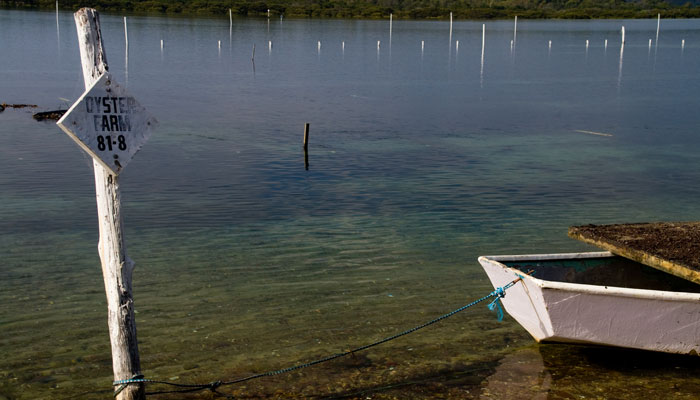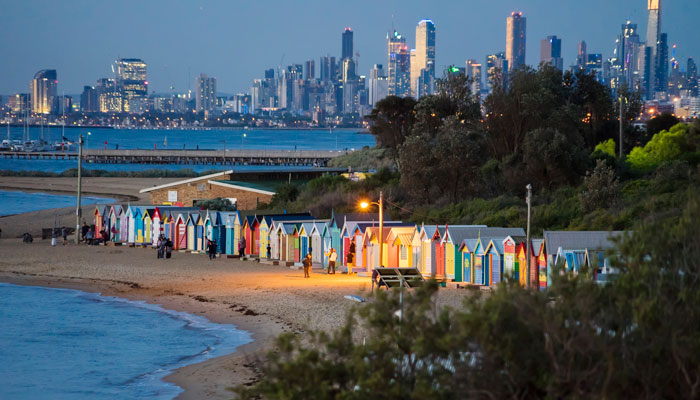The Sydney rock oyster aquaculture industry narrowly avoided being wiped out by disease earlier this century, thanks to a successful collaboration between Macquarie University researchers, oyster farmers and the NSW Department of Primary Industry.

Two centuries earlier, the wild oyster population was not so lucky; overexploitation by European settlers for food and for lime to use in construction led to the decimation of oyster reefs along Australia's eastern and southern coastlines.
Now, Macquarie researchers once again are stepping in as a burgeoning industry in oyster reef restoration promises a boon to Australia's marine environments.
From Queensland to South Australia, projects are under way to bring bivalves back to the wild. Through numerous research projects – completed, under way and planned – Macquarie scientists are discovering how the established aquaculture industry might assist this nascent restoration industry, as well as how best to restore the reefs - and how they can go on to thrive.
"It's only really the past 10 years or so that people have realised that historically we had these really abundant oyster reefs down the eastern and southern coastlines, sort of like the coral reefs in the north but formed of oysters," says Associate Professor Melanie Bishop, an ecologist in the Department of Biological Sciences.
"If you look at the diaries from the early settlers, there were these massive reefs at the entrance to Sydney harbour, which in the early 1800s we completely overexploited. The upshot was that by the mid to late 1800s we had a collapsed fishery, and there are records that they were attempting oyster reef restoration which mustn't have been too successful, so I guess they sort of escaped living memory."
More than 90 per cent of oyster reefs have been lost from the east Australian coast
It was only recently, says Bishop, that Australian researchers started trawling old fisheries inspectors' diaries and piecing together the story of these lost ecosystems that acted as water filters, mitigators of wind and wave erosion, and nurseries for a treasure house of other sea creatures.
"More than 90 per cent of oyster reefs have been lost from the east Australian coast," Bishop says.
The story is worst in Victoria, Tasmania and South Australia, where the flat, or angasi, oyster dominated and where only one known remnant reef survives, in Georges Bay, Tasmania. NSW fared better, with remnant Sydney rock oyster reefs found up and down its coast.
The many talents of oysters
In the early 2000s, when QX disease struck the Sydney rock oyster industry, Macquarie researchers helped discover how the QX parasite was causing the mass collapse and how to selectively breed for disease resistance, as well as providing research-based advice on diversification of the NSW industry to include Pacific oysters.
For their roles in the industry rescue, which has boosted oyster revenue in NSW by millions of dollars, Professor David Raftos was awarded the 2015 Eureka Prize for Rural Innovation, while Bishop in 2010 received the NSW Scientist of the Year award in the Environment, Water and Climate Change Sciences category.

Back to life: Melbourne's Port Phillip Bay is one site of oyster reef restoration programs which are also taking place in Queensland and South Australia.
Building on that success, Macquarie's research more recently focused on how oysters selectively bred for fast growth and disease resistance in aquaculture might be utilised in oyster reef restoration programs, the first of which are happening in Victoria's Port Phillip Bay, Noosa and Pumicestone Passage in Queensland, and South Australia's Gulf St Vincent. Plans are also afoot for Port Stephens in NSW.
"You might imagine disease resistance is good everywhere and fast growth might help you establish a reef quickly," Bishop says. "But usually if you're really good at one thing it means you're not so good at something else … and that turned out to be the case with the oysters."
Increasingly government is on board, and there's private sector interest too, from companies that specialise in developing artificial reefs
Macquarie PhD graduate Dominic McAfee, Bishop explains, found that while the selectively bred oysters outperformed wild bivalves at present-day temperatures, they grew slower and suffered higher mortality rates as temperature was increased.
But McAfee's research also highlighted the role oysters can play, particularly in inter-tidal zones where the temperature of sun-exposed rocks can soar to 60 degrees, in helping other animals and plants adapt to a warmer climate – particularly invertebrates such as barnacles, snails, limpets and worms that live inside the oyster shells.
"Oysters play a really important role in ameliorating temperature stress, and they do this in the intertidal zone by trapping water and providing shade. McAfee's work showed that it can be 6 to 10 degrees cooler inside the oysters than outside – and when it gets really hot, the amount of cover of oysters you have really starts to matter," Bishop says.
Potential boost for fisheries production
Support is 'massive' among recreational fishing groups for oyster reef restoration, Bishop says, because the reefs are nursery habitats for so many species.
"The shells fit together in complex configurations, and there's lots of those little invertebrates that live within the shells which in turn provide food for a whole range of recreational and commercially important fish species, and juvenile fish can also shelter in among the shells as well as from their predators," she explains.
Research by Macquarie PhD student Francisco Martinez Baena is assessing the fish communities in remnant oyster reefs in Port Stephens and Botany Bay, and comparing them to other estuarine species, such as mangrove and seagrass, that also act as nurseries for a diversity of fish species.
It has so far found that the oyster reefs are supporting species not found in the other nursery habitats, and that the diversity of reef species is equal if not higher – adding evidence to the claim that restoring oyster reefs will potentially help with fisheries production.
A fresh start with 7 million baby oysters
In South Australia's Gulf St Vincent in July, construction of the largest reef restoration outside the United States began with 7 million baby oysters, and 18,000 tonnes of limestone for them to settle on and grow, in a joint project between the state government and the University of Adelaide.
Bishop's team is in the process of applying for grants to fund research into other methods of restoration, as well as into how best to configure oyster reefs for maximum efficiency and effect, and why, in the first place, oyster reefs have not come back naturally over the centuries.
"We want to do experiments that disentangle the reasons: is it lack of hard substrate because oysters need something to settle on and historically it would have been the shells of other, dead oysters, but these were dredged during the overextraction for lime. Is there not enough oyster larvae in the water? Predators? Disease? Bad water quality?"
Whatever the findings, Bishop believes reef restoration has a big future, for the jobs it can create as well as the environmental advantages.
"Increasingly government is on board, and there's private sector interest too, from companies that specialise in developing artificial reefs," she says.
"This is potentially a massive industry."
This story was first published on December 18, 2018.






